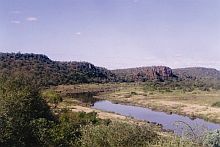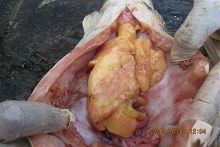Fish kill in Kruger National Park baffles experts
|
On 8 July 2009, during a crocodile sampling flight to the Olifants River gorge, Kruger National Park (KNP) officials noticed a major fish kill.
Large numbers of dead fish were found floating or washed up along the river banks, all of which were barbel (Clarias garipinus). Although some smaller (about 30 cm) dead fish were observed, most specimens appeared to be larger (about 60 cm).
During the next two days, rangers removed more than 200 dead fish that were not consumed by the crocodiles in the gorge.
Interestingly, the fish kill was very localised both in space and time, and is suspected to have taken place some time during Monday 6 July in the deep water of the Olifants gorge area, with most of the dead fish on the South African side of the gorge. According to Mozambican colleagues no dead fish were seen in Massingr Dam. There were no dead fish seen in the Olifants River upstream of the confluence either, and only three dead barbel were seen in the Letaba River.
It would appear that the barbel died at the bottom of the river and with the gas build up during the decomposition process, were popped up to the surface much later. No sick, struggling or visibly affected fish could be seen from the air. Amongst the fish carcasses, only one tilapia was found.
Due to advanced decomposition, the dead fish could not be sampled at the time, though basic post mortem examination revealed fish in very good condition with a large amount of abdominal fat (see pictures). There was also a large amount of liquefied fat on the surface of the water and in the abdomens of the fishes, most likely due to the heat released by the putrefactive process. No obvious skin or gastro-intestinal lesions were seen. All dead fish seemed to be in the same state of decomposition and looked as if they died almost at the same time.
By Monday 13 July only a few decomposed dead fish bore testimony to the kill. Some live barbel were later observed in the gorge during a survey of crocodiles.
We collected water and sediment for analysis at the time of the kill, and healthy fish were sampled as well. We did not find any sub-acutely affected fish at the time, but will continue to monitor the situation in the gorge.
Related content: The Bateleurs rally to assist SAEON with aerial surveys













